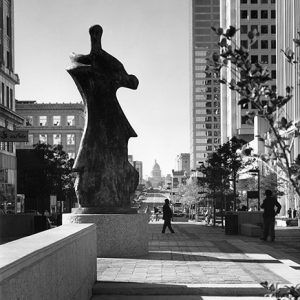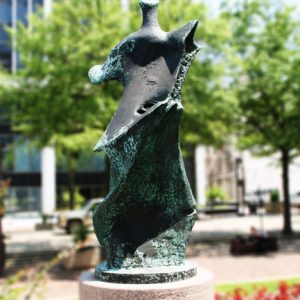calsfoundation@cals.org
Large Standing Figure: Knife Edge
aka: Standing Knife [Sculpture]
The sculpture Large Standing Figure: Knife Edge by the world-renowned British sculptor Henry Moore (1898–1986) stood for years in the courtyard of Union National Plaza on Capitol Avenue in the heart of downtown Little Rock (Pulaski County). This work was cast in bronze in 1976 and was purchased by Little Rock’s Metrocentre Commission, which placed it, in 1978, at Main Street and Capitol Avenue as the centerpiece of the Metrocentre downtown pedestrian mall project. It is considered among the state’s most noteworthy public sculptures based on its composition, which gives the sense of upward movement if not the suggestion of flight. In February 2018, it was announced that the sculpture would be moved into the Arkansas Museum of Fine Arts upon the completion of planned renovations to that building.
Henry Moore was the son of a mining engineer. He studied at the Royal Academy of Art in London and had a successful solo exhibit in 1928. His international fame came after World War II with a retrospective exhibition at the Museum of Modern Art in 1946 and a high award at the Venice Biennale of 1948. This led to works on a monumental scale such as the Lincoln Center Reclining Figure in New York (1963–65).
In 1961, Moore made the original model of Large Standing Figure: Knife Edge by combining part of the shoulder bone of a bird with modeling clay to form the statue’s head and face. He originally called the sculpture Winged Figure, and it has been noted that the upward orientation of the piece echoes the marble Victory of Samothrace in the Louvre. Another possible inspiration is the epic poem The Rescue by Edward Sackville-West. The protagonist of this Homeric poem, which Moore illustrated in 1945, is described by Sackville-West as having “something of a mysterious timelessness, the knife edge balance between being and not being, which only the poetic imagination seems able to achieve.”
The sculpture is 11’5″ tall and weighs 1,200 pounds. It is one of an edition of six. This edition was preceded by an edition of seven sculptures of a smaller version called Standing Figure: Knife Edge.
The Metrocentre Commission agreed to purchase the sculpture on June 13, 1978, at the recommendation of a search committee. Three members of the committee—James Dyke, Dr. Virginia Rembert, and Townsend Wolfe—traveled to England to meet with Moore. Rembert wrote that Moore was “pleased that it would be placed in the heart of Little Rock.” The $185,000 cost was paid for with funds assessed on property within the Metrocentre Improvement District. It was shipped from England to New Orleans and transported to a North Little Rock (Pulaski County) warehouse by truck. On Monday, September 25, 1978, the sculpture was placed on its circular marble base on the Metrocentre Mall. The sculpture was moved to its new location on Capitol Avenue and Louisiana Street in 1999 when the pedestrian mall area of Capitol Avenue was reopened to traffic. In 2023, it was placed at the entrance of the Arkansas Museum of Fine Arts upon the museum’s reopening.
The November 1978 Arkansas Times featured a cartoon depicting a group of pedestrians with a variety of comments and comic rejoinders. Below, the caption asked, “Now then, is beauty in the eye of the beholder, or in the balance of Henry Moore’s bank account?” Another reflection on the place Large Standing Figure: Knife Edge holds in Arkansas’s culture appeared in 1978 in the Pine Bluff Commercial: “There’s not all that much for us country people to envy in Little Rock, especially not the traffic and matching urban sprawl. But there’s a new exception: The statue by Henry Moore in that city’s downtown Mall. To paraphrase Will Rogers we’ve never met a work by Henry Moore we didn’t like. And this one too is evocative, powerful, a Presence.”
A replica of the sculpture appears in the high school library in the 1985 film The Breakfast Club.
For additional information:
Argan, Giulio Carlo. Henry Moore. New York: Harry N. Abrams, 1972.
Berthoud, Roger. The Life of Henry Moore. New York: E. P. Dutton, 1987.
Finn, David, et al. Henry Moore: Sculpture and Environment. New York: Harry N. Abrams, 1976.
Lieberman, William S. Henry Moore: 60 Years of His Art. New York: Thames and Hudson, 1983.
Mitchinson, David, et al. Celebrating Moore: Works from the Henry Moore Foundation. Berkeley: University of California Press, 1998.
Neumann, Erich. The Archetypal World of Henry Moore. New York: Pantheon, 1959.
Russell, John. Henry Moore. New York: G. P. Putnam’s Sons, 1968.
Spender, Stephen. Henry Moore: Sculptures in Landscape. New York: Clarkson N. Potter, 1979.
“Standing Figure Knife Edge.” Little Rock Culture Vulture. https://lrculturevulture.com/tag/standing-figure-knife-edge/ (accessed March 14, 2024).
Allen McMillan
Little Rock, Arkansas
 Arts, Culture, and Entertainment
Arts, Culture, and Entertainment Large Standing Figure: Knife Edge
Large Standing Figure: Knife Edge  Large Standing Figure: Knife Edge
Large Standing Figure: Knife Edge 



Comments
No comments on this entry yet.